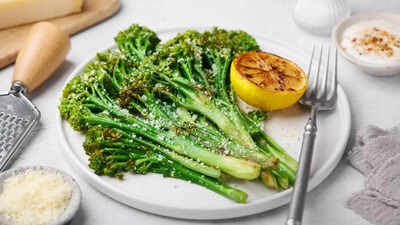If you have walked through the produce aisle lately, you might have noticed this new vegetable – broccolini. The new ‘superfood’ is gaining popularity, and some are even preferring it over broccoli. Eating vegetables is crucial for health, and yet, only one in 10 adults eats enough vegetables, according to the US Centers for Disease Control and Prevention (CDC). With broccolini’s rising reputation, should you be adding this green to your plate? But is it better than broccoli? Are there any additional nutritional benefits of opting for broccolini instead of broccoli? Let’s find out.What is a broccolini?
Broccolini is a hybrid vegetable resulting from the cross-pollination of traditional broccoli and Chinese kale (gai lan). It is often referred to as ‘baby broccoli’, but it isn’t young broccoli. This vegetable was developed in Japan in the 1980s. After eight years of breeding, the vegetable, which was initially called ‘Asparation’ for its asparagus-like stems, was trademarked as Broccolini.Broccolini’s scientific name is Brassica oleracea var. botrytis. It is a cruciferous vegetable that belongs to the Brassicaceae family, the same family as broccoli, kale, cauliflower, cabbage, and Brussels sprouts.Nutritional profile of broccolini
3.5 ounces (100 grams) of raw broccolini contains:
- Calories: 35
- Carbs: 6 grams
- Protein: 3.5 grams
- Fat: 0 grams
- Fiber: 5 grams
- Calcium: 4% of the daily value (DV)
- Iron: 7% of the DV
- Potassium: 6% of the DV
How does broccolini taste?
First introduced in the US markets in the 1990s, this vegetable is now available in many parts of the world. Contrary to broccoli’s thick, bushy heads, broccolini has long, slender stalks, topped with small, loose florets and minimal leaves. Broccolini stands out for its mild flavour, when compared to broccoli. It has a rather tender, juicy, and milder taste. It is slightly nutty and earthy. The entire plant is edible, so you can enjoy it from stem to tip. Broccoli requires more prep and has an earthier and slightly bitter taste. Broccolini, on the other hand, has thinner stems that are tender and sweet, with asparagus notes. It also cooks faster without waste.
Is broccolini better than broccoli?Though it is easy to confuse broccolini for broccoli, they differ in some aspects. However, nutritionally, both broccolini and broccoli have similar benefits. Broccolini is a good source of minerals like potassium, manganese, and phosphorus. It is especially rich in vitamin C and K. It is also an excellent source of vitamin K. Broccolini is low in calories and has high fiber. So, it may not be ideal to add broccolini to your daily diet, especially if you have gut issues such as gas or bloating. Broccolini, like other cruciferous vegetables, is rich in antioxidants and anti-inflammatory compounds. It also has potential anticancer properties. Broccolini may also provide protective effects against heart disease. So, are you stocking up your grocery cart with broccolini?











